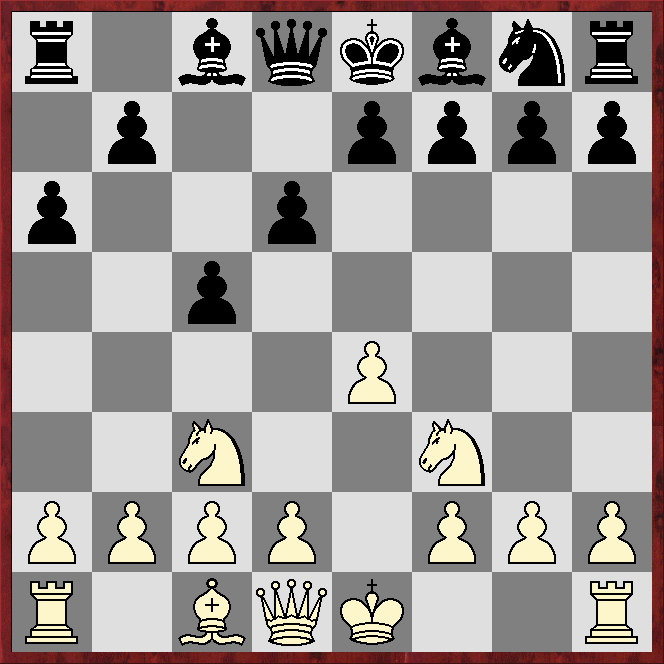Matthias Lataille (1797) - Spanton (1932)
Sicilian Closed
1.e4 c5 2.Nc3 Nc6 3.Bb5 Nd4 4.Nf3!?
White offers the bishop-pair in return for getting a sizeable lead in development. More popular is 4.Bc4, but Magnus Carlsen has played the text and it is liked by Stockfish16 and Komodo14.1.
4...Nxb5 5.Nxb5 a6 6.Nc3 d6
*****
*****
*****
*****
7.d4!?
Normally when an opponent has the bishop-pair it makes sense to keep lines closed. But here that strategy would gradually let Black catch up in development. If Black were then able to open the position, the bishops would come into their own. There is a similar trade-off in variations of the Chigorin, although there it is Black who swops off one or both bishops. Contrast this with the Exchange Variation of the Spanish, many lines of the Rossolimo in the Sicilian and many lines of the Nimzo-Indian, where structural damage rather than time is compensation for the bishop-pair.
7...cxd4 8.Qxd4 Bg4
The mainline in ChessBase's 2023 Mega database runs 8...e5!? 9.Qd3 h6 10.Nd2!? Nf6 11.Nc4 Be6 with equal chances, according to the engines, which give 9.Qb4!? as an improvement for White.
9.Nd2
The engines suggest an apparent novelty in 9.Qb4!?, claiming at least a slight edge for White.
9...Nf6 10.0-0 e6 11.Re1 Be7 12.Nf1 0-0
*****
*****
*****
*****
White's advantage in development has slowly disappeared, and Black has a typical Open Sicilian 2-1 pawn-majority on the central two files. But White has more space in the centre, and the Black bishops are not doing much - the dark-squared bishop is passive while the light-squared bishop will be a target for White's pieces. The engines reckon the position is equal.
13.Bg5
The threat is 13.Bxf6, and if 13...Bxf6 then 14.e5 wins a piece. But the engines prefer the consistent 13.Ng3
13...Bh5 14.Ng3 Bg6 15.Rad1 Qa5 16.Bd2 Qc5?!
The engines strongly dislike this, claiming Black is at least slightly better after 16...Qc7.
17.Qxc5 dxc5
 |
| Black's pawn-majority on the central two files has gone, and the position is completely equal, according to the engines |
*****
*****
*****
*****
18.f3 Rfd8 19.Be3 b5 20.b3 Rac8 21.Rxd8+ Rxd8 22.Rd1 Rxd1+ 23.Nxd1 Nh5!?
More circumspect is 23...Nd7.
24.Nxh5 Nxh5 25.c4
The black c pawn is a target.
25...f5 26.e5 f4!?
This pawn sacrifice is probably OK but the engines prefer 26...bxc4 27.bxc4 g5, eg 28.Nb2 f4 29.Bf2 Bg6 30.Na4 Bd3 31.Bxc5 Bxc5+ 32.Nxc5 Bxc4 with equality.
27.Bxf4 Bg6 28.Be3 Bb1 29.Nc3 Bd3 30.cxb5 axb5 31.Kf2 b4?!
Probably better is 31..c4, or starting to get the king into play with 31...Kf7.
32.Na4 c4?
Black may be holding after 32...Bb1.
33.bxc4?
Winning is 33.Nb2, when Black can do nothing about the threatened 34.Nxc4.
33...Bxc4 34.Bc5 Bxc5+ 35.Nxc5 Bxa2 36.Nd3 b3 37.Ke3
*****
*****
*****
*****
37...g5?
Both 37...Kf7 and 37...Bb1 seem to draw, eg 37...Kf7 38.Kd2 Kg6 39.Kc1 b2+ 40.Kxb2 Bc4 41.Ne1 Kf5 42.Kc3 Ba6 43.Kd4, after which White's extra pawn is of little value, according to the engines.
38.Kd2 Kf7 39.Kc1 Ke7?
Again Black should sacrifice the b pawn to free the bishop. After 39...b2+ 40.Kxb2 the black king is not as well placed as in the previous note, which means 40...Bc4 can be met by 41.Kc3, but that is better than the hopeless text.
40.Kb2 Kd7 41.Nc5+ Kc6?
Black is lost anyway, but this makes it easy.
The game finished:
42.Nxe6 Kd5 43.Nxg5 h6 44.e6 Kd6 45.Nf7+ Kxe6 46.Nxh6 Kf6 47.Ng4+ Kg5 48.Nf2 1-0



No comments:
Post a Comment